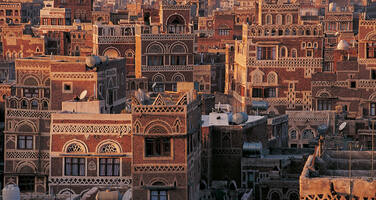Old City of Sana'a
Factors affecting the property in 1990*
- Housing
- Other Threats:
Increasing number of dilapidated buildings
UNESCO Extra-Budgetary Funds until 1990
The work carried out in the context of the campaign is being financed mostly through bilateral co-operation and is in addition to the national effort. Thus for 1990 US $16,200,000 and 2,000,000 Swiss francs have been collected.
A UNDP/Unesco project (YEM/88/006) for a cost of $374,800 has been under way since May 1988 in support of local staff training activities and fundraising.
International Assistance: requests for the property until 1990
Total amount approved : 13,000 USD
| 1990 | Mission to advise on restoration works on Sana'a Mosque (Approved) | 13,000 USD |
Missions to the property until 1990**
1989: various UNESCO missions
Conservation issues presented to the World Heritage Committee in 1990
Placed on the World Heritage List in 1986 under criteria (iv), (v) and (vi), Sana'a has since 1984 been the subject of an international safeguarding campaign, the boundaries of the area on the List being the same as those of the area for which the campaign is being conducted.
The campaign is a good example of the catalytic role that can be played by Unesco in developing international co-operation in respect of the preservation of the cultural heritage. The Government of Yemen has set up a committee specially responsible for helping to conduct the campaign and has prepared in collaboration with Unesco, a detailed action plan making it possible to schedule over a period of time the restoration and promotion activities.
At the time when the site was included in the List, and when a large number of buildings were in need of restoration, the main problems were connected with the increasing unsuitability of the facilities and architecture for living conditions in a modern capital and with the need to exercise supervision over new buildings. When it conducted an evaluation, ICOMOS raised the question of the effectiveness of including the site in the World Heritage List in view of the dangers to which it was exposed. Furthermore, in 1989 information gathered by various Unesco missions led it to be believed that a scheme for the development of the Saila Wadi was being launched and might impair the integrity of the site. The Heritage Committee expressed concern in this regard and the Yemeni authorities stated that no scheme of this kind was in progress.
The work carried out in the context of the campaign is being financed mostly through bilateral co-operation and is in addition to the national effort. Thus for 1990 US $16,200,000 and 2,000,000 Swiss francs have been collected and will in principle be used as follows:
. Italy
- Technical studies of historic centre $ 1,200,000
- Restoration of 'Italian quarter' `$ 6,400,000
. Republic of Korea
- Equipment of executive office of the international campaign $ 230,000
. Democratic People's Republic of Korea
- Technical studies $ 240,000
. Norway
- Restoration of Samsarat al-Nahas and installation of a traditional crafts centre $ 330,000
. Netherlands
- Street paving $ 700,000
- Restoration of Samsarat al Gumruk $ 700,000
. France
- Restoration of city wall, waterproofing house roofs $ 100,000
. German Federal Republic
- Restoration of Samsarat al Mansouria as an art gallery $ 300,000
- Reconstruction of Souq Al-Bajer hospital $2,000,000
. United States of America
- Restoration of Samsarat Muhammad bin Hassan bin Qassim $ 4,000,000
. Switzerland
Restoration of two historical houses and production of films and books on history, crafts, arts, and architecture of the Old City of Sana'a S.F. 2,000,000
The national authorities for their part are planning several nationally funded operations:
- . The 5th pavement project in the areas of Bahar Rejraj and Bustan Shaareb;
- . Wadi Al-Saila technical study project which will be completely finished at the end of August;
- . Three technical studies on rain water drainage and pavement projects for the areas of Bustan Sultan, Al-Dafa'ai street, Al-A'alami, A1-Felchi and Al-Quzali:
(i) general plan for public services for the Old City of Sana'a;
(ii) technical study for al-Majjah caravanserai;
(iii) restoration of two historical houses.
Of the projects in progress, four should be completed this year:
1. Ibn Al-Amir school will be finished in September this year, co-financed by Yemen Government and the Federal Republic of Germany.
2. The 4th pavement project, financed locally.
3. The southern part of the city wall, co-financed by Yemen Government and France.
4. Three public baths. They will be finished in September, financed locally.
A UNDP/Unesco project (YEM/88/006) for a cost of $374,800 has been under way since May 1988 in support of local staff training activities and fundraising. A detailed list of activities undertaken in the context of the campaign can be consulted in the Secretariat.
A request for international assistance amounting to $13,000 from the World Heritage Fund was approved in 1990 by the Chairman of the World Heritage Committee to enable the local authorities to benefit from the advice of a specialist in Islamic religious architecture for the protection and enhancement of the Great Mosque of Sana'a.
Summary of the interventions
Decisions adopted by the Committee in 1990
No draft Decision

Exports
* :
The threats indicated are listed in alphabetical order; their order does not constitute a classification according to the importance of their impact on the property.
Furthermore, they are presented irrespective of the type of threat faced by the property, i.e. with specific and proven imminent danger (“ascertained danger”) or with threats which could have deleterious effects on the property’s Outstanding Universal Value (“potential danger”).
** : All mission reports are not always available electronically.

